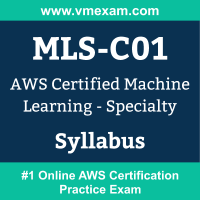 The AWS MLS-C01 exam preparation guide is designed to provide candidates with necessary information about the Machine Learning Specialty exam. It includes exam summary, sample questions, practice test, objectives and ways to interpret the exam objectives to enable candidates to assess the types of questions-answers that may be asked during the AWS Certified Machine Learning - Specialty exam.
The AWS MLS-C01 exam preparation guide is designed to provide candidates with necessary information about the Machine Learning Specialty exam. It includes exam summary, sample questions, practice test, objectives and ways to interpret the exam objectives to enable candidates to assess the types of questions-answers that may be asked during the AWS Certified Machine Learning - Specialty exam.
It is recommended for all the candidates to refer the MLS-C01 objectives and sample questions provided in this preparation guide. The AWS Machine Learning Specialty certification is mainly targeted to the candidates who want to build their career in Specialty domain and demonstrate their expertise. We suggest you to use practice exam listed in this cert guide to get used to with exam environment and identify the knowledge areas where you need more work prior to taking the actual AWS Certified Machine Learning - Specialty exam.
AWS MLS-C01 Exam Summary:
| Exam Name | AWS Certified Machine Learning - Specialty (Machine Learning Specialty) |
| Exam Code | MLS-C01 |
| Exam Price | $300 USD |
| Duration | 180 minutes |
| Number of Questions | 65 |
| Passing Score | 750 on a scale of 100 to 1000 |
| Recommended Training / Books | Practical Data Science with Amazon SageMaker |
| Schedule Exam | AWS Certification |
| Sample Questions | AWS MLS-C01 Sample Questions |
| Recommended Practice | AWS Certified Machine Learning - Specialty Practice Test |
AWS Machine Learning Specialty Syllabus:
| Section | Objectives |
|---|---|
Data Engineering - 20% |
|
| Create data repositories for ML. |
- Identify data sources (for example, content and location, primary sources such as user data). - Determine storage mediums (for example, databases, Amazon S3, Amazon Elastic File System [Amazon EFS], Amazon Elastic Block Store [Amazon EBS]). |
| Identify and implement a data ingestion solution. |
- Identify data job styles and job types (for example, batch load, streaming). - Orchestrate data ingestion pipelines (batch-based ML workloads and streaming-based ML workloads).
- Schedule jobs. |
| Identify and implement a data transformation solution. |
- Transform data in transit (ETL, AWS Glue, Amazon EMR, AWS Batch). - Handle ML-specific data by using MapReduce (for example, Apache Hadoop, Apache Spark, Apache Hive). |
Exploratory Data Analysis - 24% |
|
| Sanitize and prepare data for modeling. |
- Identify and handle missing data, corrupt data, and stop words.
|
| Perform feature engineering. |
- Identify and extract features from datasets, including from data sources such as text, speech, image, public datasets. - Analyze and evaluate feature engineering concepts (for example, binning, tokenization, outliers, synthetic features, one-hot encoding, reducing dimensionality of data). |
| Analyze and visualize data for ML. |
- Create graphs (for example, scatter plots, time series, histograms, box plots). - Interpret descriptive statistics (for example, correlation, summary statistics, p-value). - Perform cluster analysis (for example, hierarchical, diagnosis, elbow plot, cluster size). |
Modeling - 36% |
|
| Frame business problems as ML problems. |
- Determine when to use and when not to use ML. - Know the difference between supervised and unsupervised learning. - Select from among classification, regression, forecasting, clustering, and recommendation and foundation models. |
| Select the appropriate model(s) for a given ML problem. |
- XGBoost, logistic regression, k-means, linear regression, decision trees, random forests, RNN, CNN, ensemble, transfer learning and large language models (LLMs) - Express the intuition behind models. |
| Train ML models. |
- Split data between training and validation (for example, cross validation). - Understand optimization techniques for ML training (for example, gradient descent, loss functions, convergence). - Choose appropriate compute resources (for example GPU or CPU, distributed or non-distributed).
- Update and retrain models.
|
| Perform hyperparameter optimization. |
- Perform regularization.
- Perform cross-validation. |
| Evaluate ML models. |
- Avoid overfitting or underfitting.
- Evaluate metrics (for example, area under curve [AUC]-receiver operating characteristics [ROC], accuracy, precision, recall, Root Mean Square Error [RMSE], F1 score). |
Machine Learning Implementation and Operations - 20% |
|
| Build ML solutions for performance, availability, scalability, resiliency, and fault tolerance. |
- Log and monitor AWS environments.
- Deploy to multiple AWS Regions and multiple Availability Zones. |
| Recommend and implement the appropriate ML services and features for a given problem. |
- ML on AWS (application services), for example:
- Understand AWS service quotas.
|
| Apply basic AWS security practices to ML solutions. |
- AWS Identity and Access Management (IAM) - S3 bucket policies - Security groups - VPCs - Encryption and anonymization |
| Deploy and operationalize ML solutions. |
- Expose endpoints and interact with them.
|
